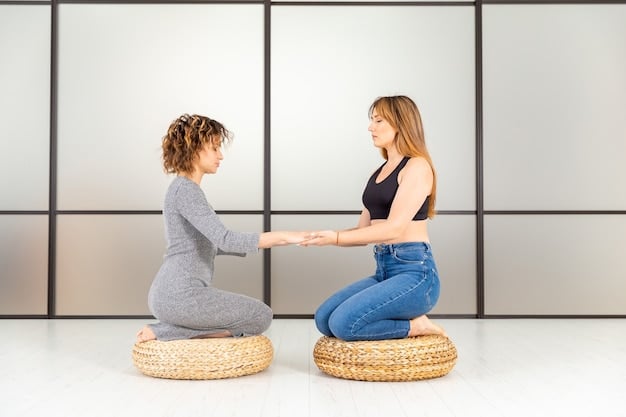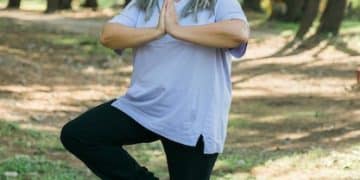Modify Yoga Poses Safely: Insider Secrets for Injuries & Limitations

Modifying yoga poses is crucial for individuals with injuries and limitations, allowing them to enjoy the benefits of yoga while minimizing risks and preventing further harm by adjusting poses to suit their body’s needs.
Yoga is a fantastic practice for both body and mind, but it’s not a one-size-fits-all activity. This guide unveils the insider secrets on how to modify yoga poses for injuries and limitations, ensuring a safe and enjoyable experience for everyone.
Understanding Your Body and Yoga
Before diving into specific pose modifications, it’s essential to understand your body and its limitations. Yoga is not about pushing yourself to the extreme; it’s about listening to your body and respecting its boundaries. Recognizing your body’s signals is the key to preventing injuries and maximizing the benefits of your practice.
Assessing Your Physical Limitations
Start by identifying any pre-existing injuries, chronic pain, or physical limitations you might have. This could include anything from back pain and knee issues to shoulder problems or limited range of motion. Knowing your limitations will help you make informed decisions about which poses might need modification.
Listening to Your Body’s Signals
During your yoga practice, pay close attention to what your body is telling you. If you experience any sharp or shooting pain, stop immediately. Mild discomfort or stretching sensations are normal, but pain is a sign that something is not right. Respect your body’s signals, and don’t push past your comfort zone.
Here are some key points to keep in mind:
- Know your limits: Understand your body’s current capabilities and limitations.
- Listen to your body: Pay attention to pain signals and adjust accordingly.
- Be patient: Progress slowly and gradually over time.
Ultimately, yoga is a personal journey, and respecting your body is paramount. By understanding your limitations and listening to your body, you can tailor your practice to suit your unique needs and prevent injuries.

Essential Modifications for Common Injuries
Many yoga poses can be modified to accommodate common injuries and limitations. These modifications allow you to continue practicing yoga safely and effectively while protecting your body from further harm. Let’s explore some essential modifications for common injuries.
Modifications for Back Pain
Back pain is a common ailment that can be exacerbated by certain yoga poses. Focus on poses that strengthen your core and support your spine. Avoid deep backbends and forward folds that put excessive strain on your lower back. A gentle twist can be included as long as it feels good for you.
Modifications for Knee Injuries
Knee injuries can make certain yoga poses challenging and painful. Modify poses to reduce stress on your knees by avoiding deep bends and twists. Use props like blankets or blocks to support your knees and maintain proper alignment.
Here are some modifications for knee injuries:
- Use props: Place a blanket or folded towel under your knees for support.
- Avoid deep bends: Modify poses like Warrior II and Triangle Pose by keeping your front knee aligned over your ankle.
- Engage your core: Strengthen your core muscles to stabilize your hips and reduce stress on your knees.
Modifying yoga poses for common injuries involves understanding the specific needs of your body and adjusting your practice accordingly. By using props, modifying alignments, and listening to your body’s signals, you can enjoy the benefits of yoga while protecting yourself from further harm.
Using Props to Enhance Your Practice
Yoga props such as blocks, straps, and bolsters can be invaluable tools for modifying poses and supporting your body. Props help you achieve proper alignment, increase stability, and deepen your stretches safely. Incorporating props into your practice can make yoga more accessible and enjoyable, especially if you have injuries or limitations.
Benefits of Using Yoga Blocks
Yoga blocks can be used to shorten the distance between your hands and the floor, making poses like Triangle Pose and Half Moon Pose more accessible. They can also provide support in poses like Seated Forward Fold, allowing you to maintain a straighter spine and reduce strain on your lower back.
How Straps Can Help
Yoga straps can extend your reach and help you achieve proper alignment in poses like Cow Face Pose and Reclining Hand-to-Big-Toe Pose. Straps allow you to maintain a gentle stretch without overstraining your muscles, making them particularly useful for individuals with limited flexibility.
Here are ways to use props in Yoga:
- Blocks for support: Use blocks under your hands in standing poses to maintain proper alignment.
- Straps for stretching: Use straps to deepen stretches without overstraining.
- Bolsters for comfort: Use bolsters for extra support during restorative and sitting poses.
Yoga props are powerful tools that can enhance your practice and make yoga more accessible, regardless of your physical limitations. By using props strategically, you can improve your alignment, increase your stability, and deepen your stretches safely and effectively.

Breathing Techniques for Pain Management
Breathing techniques, or pranayama, are integral to yoga practice. They can help calm the mind, reduce stress, and manage pain. Learning to breathe deeply and mindfully can enhance your overall well-being and improve your ability to cope with physical discomfort. Certain breathing techniques will help calm you down.
Diaphragmatic Breathing
Diaphragmatic breathing, also known as belly breathing, involves expanding your abdomen as you inhale and contracting it as you exhale. This technique can help reduce stress, lower blood pressure, and alleviate pain by promoting relaxation and increasing oxygen flow to your muscles.
Alternate Nostril Breathing
Alternate nostril breathing, or Nadi Shodhana, involves alternating between inhaling through one nostril and exhaling through the other. This technique can help balance the nervous system, reduce anxiety, and improve focus. When anxious, just breath.
Here are simple breathing exercises to help with pain management:
- Deep belly breathing: Inhale deeply through your nose, expanding your abdomen, and exhale slowly through your mouth.
- Alternate nostril breathing: Close one nostril and inhale through the other, then switch and exhale.
- Ujjayi breath: Create a slight constriction in the back of your throat as you breathe, producing a soft, ocean-like sound.
Breathing techniques are powerful tools for pain management and overall well-being. By incorporating these techniques into your yoga practice and daily life, you can reduce stress, alleviate pain, and improve your overall sense of calm and balance.
Progressing Safely and Avoiding Overexertion
Progressing safely in yoga is crucial for preventing injuries and maintaining a sustainable practice. It’s important to gradually increase the intensity and duration of your workouts over time, while always listening to your body and respecting its limits. Avoid overexertion by pacing yourself, taking breaks when needed, and focusing on proper alignment.
Gradual Progression
Avoid the temptation to rush into advanced poses or push yourself too hard too soon. Start with basic poses and gradually progress to more challenging variations as your strength and flexibility improve. Consistency is key to building a strong foundation and avoiding injuries.
Rest and Recovery
Allow your body adequate time to rest and recover between yoga sessions. Overtraining can lead to muscle fatigue, joint pain, and an increased risk of injury. Incorporate rest days into your schedule and listen to your body’s need for recovery.
In order to progress safely and avoid overexertion do these key things:
- Start slowly: Begin with basic poses and gradually progress to more challenging variations.
- Listen to your body: Pay attention to pain signals and modify poses as needed.
- Rest and recover: Allow your body adequate time to rest between yoga sessions.
Progressing safely in yoga involves patience, self-awareness, and a commitment to honoring your body’s limits. By gradually increasing the intensity and duration of your workouts, prioritizing rest and recovery, and focusing on proper alignment, you can enjoy the benefits of yoga while minimizing the risk of injury.
Finding the Right Yoga Style for Your Needs
Different styles of yoga can vary significantly in terms of intensity, focus, and physical demands. Finding the right style for your needs is essential for creating a safe and enjoyable practice. Beginners, individuals with injuries, and those seeking a more gentle approach may benefit from restorative, or gentle yoga.
Restorative Yoga
Restorative yoga involves holding passive poses for extended periods, typically supported by props such as bolsters, blankets, and blocks. This style promotes deep relaxation, reduces stress, and alleviates pain by allowing your body to fully relax and release tension.
Hatha Yoga
Hatha yoga is a general term for many types of yoga. Hatha is considered a gentle style, but that is up to the instructor. This style includes poses that focus on improving the whole body.
Finding the right Yoga starts with these three tips:
- Gentle Yoga: Focuses on deep breathing an relaxation.
- Hatha Yoga: Improves overall body health.
- Vinyasa Yoga: More intense and focuses on building strength.
Finding the right style of yoga for your needs involves exploring different options, consulting with experienced instructors, and tuning into your body’s response. By considering your goals, physical limitations, and personal preferences, you can discover a yoga style that supports your well-being and enhances your overall quality of life.
| Key Point | Brief Description |
|---|---|
| 🧘 Listen to Your Body | Pay attention to pain and only progress as you feel comfortable. |
| 🧱 Use Props | Blocks, straps, and bolsters can help modify and support poses. |
| 🌬️ Practice Breathing | Techniques like diaphragmatic breathing can help manage pain and stress. |
| 🌱 Gradual Progression | Slowly increase intensity and duration, avoiding overexertion. |
FAQ
▼
If you feel sharp or shooting pain, stop the pose immediately. Mild discomfort is acceptable, but pain indicates a need for modification or discontinuation.
▼
Props like blocks, straps, and bolsters provide support, improve alignment, and allow for deeper stretches without straining muscles, making poses more accessible.
▼
Diaphragmatic breathing, or belly breathing, is highly effective for reducing stress and pain by promoting relaxation and increasing oxygen flow to the muscles.
▼
Practice frequency depends on your body and the severity of your injuries. Start with shorter, gentler sessions and gradually increase as you feel comfortable, always prioritizing rest and recovery.
▼
Restorative yoga is often the best choice for those with physical limitations, as it focuses on deep relaxation and gentle poses supported by props, minimizing strain on the body.
Conclusion
Modifying yoga poses to accommodate injuries and limitations is a mindful and empowering approach that allows everyone to experience the benefits of yoga safely. By understanding your body, using props, practicing breathing techniques, and progressing gradually, you can create a sustainable and enjoyable yoga practice that supports your overall well-being, regardless of physical challenges.





